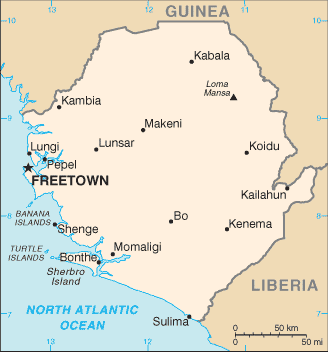Sierra Leone is located in Western Africa between Guinea and Liberia. The total area of the country is 71,740 km2 with a population of 5,485,998 as of July 2012. Its climate is mostly tropical.
 |
The national flag of Sierra Leone.
Image Credits: CIA Factbook. |
Since Sierra Leone gained independence in 1966, it has worked towards being one of the most active economies in the African continent, strengthened by a stable government, significant capital investment, good social reforms, and foreign aid. However, there are some challenges facing this small country such as unemployment and AIDS, which are deterrents to its economic growth. The civil wars that lasted more than 10 years have also slowed down its economy. The country's government is now trying to escalate development, generate jobs, and eradicate endemic corruption. The GDP of the country in 2011 was $5.158 billion.
Sierra Leone has a rich supply of natural resources including diamonds, iron ore, gold, titanium ore, bauxite, and chromite. Alluvial diamond mining continues to be a major source of revenue for the country accounting for almost half of Sierra Leone's exports. However, a lot of bloodshed was caused as warring groups fought to control the diamond fields, giving rise to the term ‘blood diamonds’. The revival of bauxite and rutile mining has also aided the country’s gradual progress out of poverty in the recent years.
Overview of Resources
Sierra Leone was the 10th largest producer of diamond and the third largest producer of rutile in the world in 2010. The country also produces mineral commodities such as cement and ilmenite.
Sierra Leone’s mineral and metal production statistics for 2010 is as follows:
- Bauxite increased by 44% to 1.0 Mt from 757,000 Mt in 2009
- Cement increased by 27.4% to 300,980 Mt from 236,240 Mt in 2009
- Diamond increased by 9.2% to 437,516 carats
- Gold increased by 72.2% to 270 kg
- Ilmenite increased by 20% to 18,206 t
- Rutile increased by 6.8% to 68,198 t

The map of Sierra Leone. Image Credits: CIA Factbook.
Metals
Baomahun Gold Ltd., a subsidiary of London-based Cluff Gold plc, owns a 100% interest in the Baomahun gold project. The company claimed that there has been a 27% production increase at the project in 2010. Assessments carried out at the project indicate that the Baomahun mine has an eight year life period with an average production of 4,883 kg/yr.
The Komahun gold project at Nimini Hill concession in east-central Sierra Leone is operated by Axmin Inc. of Canada. Initial assessments at the project site indicated that an underground gold mine with a six-year mine life can be developed to produce about 1,600 kg/yr.
Bermuda-based African Minerals Ltd. (AML) has 100% ownership of the Tonkolili iron ore project situated in the Sula Mountains Greenstone Belt. The Government of Sierra Leone has granted the company a mining lease for the project along with two mining licenses for a period of 25 years.
In 2010, Sierra Leone’s only bauxite mine was operated by Netherlands-based Vimetco N.V. However, in the same year, a joint venture was established between Sierra Leone Exploration and Mining Company Ltd. (SLEMCO) and India-based ABG Shipyard Co. to mine bauxite in Porto Loko District after satellite observations indicated 321 Mt bauxite reserves. The joint venture aims to produce 10 Mt/yr for a period of 34 years. They are also planning to construct a $400 million alumina refinery.
Industrial Minerals and Gemstones
The diamond export statistics provided by the Kimberley Process Certification Scheme indicate that a total of 550,395 carats of diamond amounting to $129.6 million was exported in 2010.
Millennium Mining LLC of Sierra Leone solely operated the alluvial diamond mine in Sewa River until 2010, when New York-based Dolat Ventures Inc. gained a 75% claim over the company. The production at this mining site is about 7 to 10 carats/day of diamond.
Sierra Leone Hard Rock Ltd., a subsidiary of Guernsey-Paragon Diamonds Ltd., has 100% ownership of the Konoma alluvial diamond project located in the Kono District. The company holds four mining exploration licenses.
Fossil Fuels
Currently, Sierra Leone does not produce or refine petroleum and relies on imports for its petroleum requirements. The mineral fuel industry of the country is in its exploration stage.
Investment
Experts believe that Sierra Leone’s economy will continue to greatly rely on the income from the diamond sector in the near future. In the meantime, the government has massive plans to upgrade the country’s infrastructure with new ports, railroads, power plants, and roads to aid the mineral industry’s development. It has also initiated the new Mines and Minerals Act to ensure a transparent investment environment so as to encourage foreign investment in this sector.
This mineral-rich nation is in need of guidance and technology to convert its mineral reserves into revenue and in turn uplift its low standard of living and clear its huge unpaid debt that runs into the billions.
Disclaimer: The Author of this article does not imply any investment recommendation and some content is speculative in nature. The Author is not affiliated in any way with any companies mentioned and all statistical information is publically available.
Sources and Further Reading
Disclaimer: The views expressed here are those of the author expressed in their private capacity and do not necessarily represent the views of AZoM.com Limited T/A AZoNetwork the owner and operator of this website. This disclaimer forms part of the Terms and conditions of use of this website.